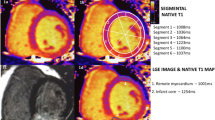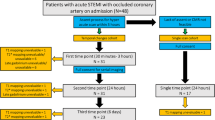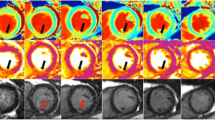Abstract
Aims
To test T1 and T2 mapping in the assessment of acute myocardial injury in patients with non-ST-segment elevation myocardial infarction (NSTEMI), evaluated before revascularization.
Methods
Forty-seven patients with acute NSTEMI underwent cardiac magnetic resonance (CMR) at 1.5 T, including T1 and T2 mapping.
Results
Coronary angiography (CA) evidenced an obstructive coronary artery disease (CAD) in 36 patients (80%) and a non-obstructive CAD in 11 patients (20%). Edema was detected in 51.1/65.9% of patients in T1/T2 maps, respectively. This difference was due to artifacts in T1 maps. T1/T2 values were significantly higher in the infarcted myocardium (IM) compared with the remote myocardium (RM) (in T1: 1151.6 ± 53.5 ms vs. 958.2 ± 38.6 ms, respectively; in T2: 69 ± 6 ms vs. 51.9 ± 2.9 ms, respectively; p < 0.0001 for both). We found both an obstructive CAD at CA and myocardial edema at CMR in 53.2% of patients, while 8.5% of patients had a non-obstructive CAD and no edema. However, 25.5% of patients had an obstructive CAD without edema, while 12.8% of patients showed edema despite a non-obstructive CAD. Furthermore, in 6 of the edema-positive patients with multi-vessels obstructive CAD, CMR identified myocardial edema in a vascular territory different from that of the lesion supposed to be the culprit at CA.
Conclusions
In a non-negligible percentage of NSTEMI patients, T1 and T2 mapping detect myocardial edema without significant stenosis at CA and vice versa. Therefore, CA and CMR edema imaging might provide complementary information in the evaluation of NSTEMI.



Similar content being viewed by others
Abbreviations
- 2ch:
-
Two-chamber
- 4ch:
-
Four-chamber
- AAR:
-
Area at risk
- CA:
-
Coronary angiography
- CAD:
-
Coronary artery disease
- CMR:
-
Cardiac magnetic resonance
- FFR:
-
Fractional flow reserve
- hs-cTn-T:
-
High-sensitivity cardiac troponin T
- IM:
-
Infarcted myocardium
- LGE:
-
Late gadolinium enhancement
- MI:
-
Myocardial infarction
- MOLLI:
-
Modified look-locker inversion recovery
- NSTE-ACS:
-
Non-ST-segment elevation acute coronary syndrome
- NSTEMI:
-
Non-ST-segment elevation myocardial infarction
- PCI:
-
Percutaneous coronary intervention
- RM:
-
Remote myocardium
- ROI:
-
Region of interest
- STEMI:
-
ST-segment elevation myocardial infarction
- STIR:
-
Short-tau inversion recovery
- WIP:
-
Work-In-Progress
- WMSI:
-
Wall motion score index
References
Giri S, Chung YC, Merchant A, Mihai G, Rajagopalan S, Raman SV, Simonetti OP (2009) T2 quantification for improved detection of myocardial edema. J Cardiovasc Magn Reson 11:56. https://doi.org/10.1186/1532-429X-11-56
Verhaert D, Thavendiranathan P, Giri S, Mihai G, Rajagopalan S, Simonetti OP, Raman SV (2011) Direct T2 quantification of myocardial edema in acute ischemic injury. JACC Cardiovasc Imaging 4(3):269–278. https://doi.org/10.1016/j.jcmg.2010.09.023
Messroghli DR, Plein S, Higgins DM, Walters K, Jones TR, Ridgway JP, Sivananthan MU (2006) Human myocardium: single-breath-hold MR T1 mapping with high spatial resolution—reproducibility study. Radiology 238(3):1004–1012. https://doi.org/10.1148/radiol.2382041903
Langhans B, Nadjiri J, Jahnichen C, Kastrati A, Martinoff S, Hadamitzky M (2014) Reproducibility of area at risk assessment in acute myocardial infarction by T1- and T2-mapping sequences in cardiac magnetic resonance imaging in comparison to Tc99m-sestamibi SPECT. Int J Cardiovasc Imaging 30(7):1357–1363. https://doi.org/10.1007/s10554-014-0467-z
Dall’Armellina E, Piechnik SK, Ferreira VM, Si QL, Robson MD, Francis JM, Cuculi F, Kharbanda RK, Banning AP, Choudhury RP, Karamitsos TD, Neubauer S (2012) Cardiovascular magnetic resonance by non contrast T1-mapping allows assessment of severity of injury in acute myocardial infarction. J Cardiovasc Magn Reson 14:15. https://doi.org/10.1186/1532-429X-14-15
Ferreira VM, Piechnik SK, Dall’Armellina E, Karamitsos TD, Francis JM, Ntusi N, Holloway C, Choudhury RP, Kardos A, Robson MD, Friedrich MG, Neubauer S (2013) T(1) mapping for the diagnosis of acute myocarditis using CMR: comparison to T2-weighted and late gadolinium enhanced imaging. JACC Cardiovasc Imaging 6(10):1048–1058. https://doi.org/10.1016/j.jcmg.2013.03.008
McAlindon EJ, Pufulete M, Harris JM, Lawton CB, Moon JC, Manghat N, Hamilton MC, Weale PJ, Bucciarelli-Ducci C (2015) Measurement of myocardium at risk with cardiovascular MR: comparison of techniques for edema imaging. Radiology 275(1):61–70. https://doi.org/10.1148/radiol.14131980
h-Ici DO, Jeuthe S, Al-Wakeel N, Berger F, Kuehne T, Kozerke S, Messroghli DR (2014) T1 mapping in ischaemic heart disease. Eur Heart J Cardiovasc Imaging 15(6):597–602. https://doi.org/10.1093/ehjci/jeu024
Saremi F (2017) Cardiac MR imaging in acute coronary syndrome: application and image interpretation. Radiology 282(1):17–32. https://doi.org/10.1148/radiol.2016152849
Bulluck H, White SK, Rosmini S, Bhuva A, Treibel TA, Fontana M, Abdel-Gadir A, Herrey A, Manisty C, Wan SM, Groves A, Menezes L, Moon JC, Hausenloy DJ (2015) T1 mapping and T2 mapping at 3T for quantifying the area-at-risk in reperfused STEMI patients. J Cardiovasc Magn Reson 17(1):73. https://doi.org/10.1186/s12968-015-0173-6
Amsterdam EA, Wenger NK, Brindis RG, Casey DE Jr, Ganiats TG, Holmes DR Jr, Jaffe AS, Jneid H, Kelly RF, Kontos MC, Levine GN, Liebson PR, Mukherjee D, Peterson ED, Sabatine MS, Smalling RW, Zieman SJ, Members AATF, Society for Cardiovascular A, Interventions, the Society of Thoracic S (2014) 2014 AHA/ACC guideline for the management of patients with non-ST-elevation acute coronary syndromes: executive summary: a report of the American College of Cardiology/American Heart Association Task Force on Practice Guidelines. Circulation 130(25):2354–2394. https://doi.org/10.1161/cir.0000000000000133
Anderson RD (2016) Does RIDDLE-NSTEMI provide an answer to the timing of ACS therapy? JACC Cardiovasc Interv 9(6):550–552. https://doi.org/10.1016/j.jcin.2016.01.020
Roffi M, Patrono C, Collet JP, Mueller C, Valgimigli M, Andreotti F, Bax JJ, Borger MA, Brotons C, Chew DP, Gencer B, Hasenfuss G, Kjeldsen K, Lancellotti P, Landmesser U, Mehilli J, Mukherjee D, Storey RF, Windecker S, Baumgartner H, Gaemperli O, Achenbach S, Agewall S, Badimon L, Baigent C, Bueno H, Bugiardini R, Carerj S, Casselman F, Cuisset T, Erol C, Fitzsimons D, Halle M, Hamm C, Hildick-Smith D, Huber K, Iliodromitis E, James S, Lewis BS, Lip GY, Piepoli MF, Richter D, Rosemann T, Sechtem U, Steg PG, Vrints C, Luis Zamorano J (2016) 2015 ESC guidelines for the management of acute coronary syndromes in patients presenting without persistent ST-segment elevation: task force for the management of acute coronary syndromes in patients presenting without persistent ST-segment elevation of the European Society of Cardiology (ESC). Eur Heart J 37(3):267–315. https://doi.org/10.1093/eurheartj/ehv320
Layland J, Rauhalammi S, Lee MM, Ahmed N, Carberry J, Teng Yue May V, Watkins S, McComb C, Mangion K, McClure JD, Carrick D, O’Donnell A, Sood A, McEntegart M, Oldroyd KG, Radjenovic A, Berry C (2017) Diagnostic accuracy of 3.0-T magnetic resonance T1 and T2 mapping and T2-weighted dark-blood imaging for the infarct-related coronary artery in non-ST-segment elevation myocardial infarction. J Am Heart Assoc. https://doi.org/10.1161/jaha.116.004759
Cho MS, Ahn JM, Lee CH, Kang DY, Lee JB, Lee PH, Kang SJ, Lee SW, Kim YH, Lee CW, Park SW, Park DW, Park SJ (2017) Differential rates and clinical significance of periprocedural myocardial infarction after stenting or bypass surgery for multivessel coronary disease according to various definitions. JACC Cardiovasc Interv 10(15):1498–1507. https://doi.org/10.1016/j.jcin.2017.05.051
Fernandez-Jimenez R, Garcia-Prieto J, Sanchez-Gonzalez J, Aguero J, Lopez-Martin GJ, Galan-Arriola C, Molina-Iracheta A, Doohan R, Fuster V, Ibanez B (2015) Pathophysiology underlying the bimodal edema phenomenon after myocardial ischemia/reperfusion. J Am Coll Cardiol 66(7):816–828. https://doi.org/10.1016/j.jacc.2015.06.023
Fernandez-Jimenez R, Barreiro-Perez M, Martin-Garcia A, Sanchez-Gonzalez J, Aguero J, Galan-Arriola C, Garcia-Prieto J, Diaz-Pelaez E, Vara P, Martinez I, Zamarro I, Garde B, Sanz J, Fuster V, Sanchez PL, Ibanez B (2017) Dynamic edematous response of the human heart to myocardial infarction: implications for assessing myocardial area at risk and salvage. Circulation 136(14):1288–1300. https://doi.org/10.1161/CIRCULATIONAHA.116.025582
Moon JC, Messroghli DR, Kellman P, Piechnik SK, Robson MD, Ugander M, Gatehouse PD, Arai AE, Friedrich MG, Neubauer S, Schulz-Menger J, Schelbert EB, Society for Cardiovascular Magnetic Resonance I, Cardiovascular Magnetic Resonance Working Group of the European Society of C (2013) Myocardial T1 mapping and extracellular volume quantification: a Society for Cardiovascular Magnetic Resonance (SCMR) and CMR Working Group of the European Society of Cardiology consensus statement. J Cardiovasc Magn Reson 15:92. https://doi.org/10.1186/1532-429x-15-92
Cerqueira MD, Weissman NJ, Dilsizian V, Jacobs AK, Kaul S, Laskey WK, Pennell DJ, Rumberger JA, Ryan T, Verani MS, American Heart Association Writing Group on Myocardial S, Registration for Cardiac I (2002) Standardized myocardial segmentation and nomenclature for tomographic imaging of the heart. A statement for healthcare professionals from the Cardiac Imaging Committee of the Council on Clinical Cardiology of the American Heart Association. Circulation 105(4):539–542
Moon JC, De Arenaza DP, Elkington AG, Taneja AK, John AS, Wang D, Janardhanan R, Senior R, Lahiri A, Poole-Wilson PA, Pennell DJ (2004) The pathologic basis of Q-wave and non-Q-wave myocardial infarction: a cardiovascular magnetic resonance study. J Am Coll Cardiol 44(3):554–560. https://doi.org/10.1016/j.jacc.2004.03.076
Kim RJ, Albert TS, Wible JH, Elliott MD, Allen JC, Lee JC, Parker M, Napoli A, Judd RM, Gadoversetamide Myocardial Infarction Imaging I (2008) Performance of delayed-enhancement magnetic resonance imaging with gadoversetamide contrast for the detection and assessment of myocardial infarction: an international, multicenter, double-blinded, randomized trial. Circulation 117(5):629–637. https://doi.org/10.1161/CIRCULATIONAHA.107.723262
Sievers B, Elliott MD, Hurwitz LM, Albert TS, Klem I, Rehwald WG, Parker MA, Judd RM, Kim RJ (2007) Rapid detection of myocardial infarction by subsecond, free-breathing delayed contrast-enhancement cardiovascular magnetic resonance. Circulation 115(2):236–244. https://doi.org/10.1161/CIRCULATIONAHA.106.635409
Eitel I, Desch S, Fuernau G, Hildebrand L, Gutberlet M, Schuler G, Thiele H (2010) Prognostic significance and determinants of myocardial salvage assessed by cardiovascular magnetic resonance in acute reperfused myocardial infarction. J Am Coll Cardiol 55(22):2470–2479. https://doi.org/10.1016/j.jacc.2010.01.049
Friedrich MG, Abdel-Aty H, Taylor A, Schulz-Menger J, Messroghli D, Dietz R (2008) The salvaged area at risk in reperfused acute myocardial infarction as visualized by cardiovascular magnetic resonance. J Am Coll Cardiol 51(16):1581–1587. https://doi.org/10.1016/j.jacc.2008.01.019
Kerensky RA, Wade M, Deedwania P, Boden WE, Pepine CJ, Veterans Affairs Non QWISi-HTI (2002) Revisiting the culprit lesion in non-Q-wave myocardial infarction. Results from the VANQWISH trial angiographic core laboratory. J Am Coll Cardiol 39(9):1456–1463
Mueller C (2014) Biomarkers and acute coronary syndromes: an update. Eur Heart J 35(9):552–556. https://doi.org/10.1093/eurheartj/eht530
Reiter U, Reiter G, Dorr K, Greiser A, Maderthaner R, Fuchsjager M (2014) Normal diastolic and systolic myocardial T1 values at 1.5-T MR imaging: correlations and blood normalization. Radiology 271(2):365–372. https://doi.org/10.1148/radiol.13131225
von Knobelsdorff-Brenkenhoff F, Prothmann M, Dieringer MA, Wassmuth R, Greiser A, Schwenke C, Niendorf T, Schulz-Menger J (2013) Myocardial T1 and T2 mapping at 3 T: reference values, influencing factors and implications. J Cardiovasc Magn Reson 15:53. https://doi.org/10.1186/1532-429X-15-53
Tessa C, Diciotti S, Landini N, Lilli A, Del Meglio J, Salvatori L, Giannelli M, Greiser A, Vignali C, Casolo G (2015) Myocardial T1 and T2 mapping in diastolic and systolic phase. Int J Cardiovasc Imaging 31(5):1001–1010. https://doi.org/10.1007/s10554-015-0639-5
Bonner F, Janzarik N, Jacoby C, Spieker M, Schnackenburg B, Range F, Butzbach B, Haberkorn S, Westenfeld R, Neizel-Wittke M, Flogel U, Kelm M (2015) Myocardial T2 mapping reveals age- and sex-related differences in volunteers. J Cardiovasc Magn Reson 17(1):9. https://doi.org/10.1186/s12968-015-0118-0
Tahir E, Sinn M, Bohnen S, Avanesov M, Saring D, Stehning C, Schnackenburg B, Eulenburg C, Wien J, Radunski UK, Blankenberg S, Adam G, Higgins CB, Saeed M, Muellerleile K, Lund GK (2017) Acute versus chronic myocardial infarction: diagnostic accuracy of quantitative native T1 and T2 mapping versus assessment of edema on standard T2-weighted cardiovascular MR images for differentiation. Radiology 285(1):83–91. https://doi.org/10.1148/radiol.2017162338
Raman SV, Simonetti OP, Winner MW 3rd, Dickerson JA, He X, Mazzaferri EL Jr, Ambrosio G (2010) Cardiac magnetic resonance with edema imaging identifies myocardium at risk and predicts worse outcome in patients with non-ST-segment elevation acute coronary syndrome. J Am Coll Cardiol 55(22):2480–2488. https://doi.org/10.1016/j.jacc.2010.01.047
Ferreira VM, Piechnik SK, Robson MD, Neubauer S, Karamitsos TD (2014) Myocardial tissue characterization by magnetic resonance imaging: novel applications of T1 and T2 mapping. J Thorac Imaging 29(3):147–154. https://doi.org/10.1097/RTI.0000000000000077
Abdel-Aty H, Zagrosek A, Schulz-Menger J, Taylor AJ, Messroghli D, Kumar A, Gross M, Dietz R, Friedrich MG (2004) Delayed enhancement and T2-weighted cardiovascular magnetic resonance imaging differentiate acute from chronic myocardial infarction. Circulation 109(20):2411–2416. https://doi.org/10.1161/01.CIR.0000127428.10985.C6
Tessa C, Casolo G, Del Meglio J, Diciotti S, Vignali C, Giannelli M (2018) Can T1 mapping be used to differentiate between acute and chronic myocardial infarctions? Radiology 287(2):726–727. https://doi.org/10.1148/radiol.2018172733
Messroghli DR, Walters K, Plein S, Sparrow P, Friedrich MG, Ridgway JP, Sivananthan MU (2007) Myocardial T1 mapping: application to patients with acute and chronic myocardial infarction. Magn Reson Med 58(1):34–40. https://doi.org/10.1002/mrm.21272
Bulluck H, Bryant JA, Lim MX, Tan XW, Ramlall M, Francis R, Kotecha T, Cabrera-Fuentes HA, Knight DS, Fontana M, Moon JC, Hausenloy DJ (2017) Full left ventricular coverage is essential for the accurate quantification of the area-at-risk by T1 and T2 mapping. Sci Rep 7(1):4871. https://doi.org/10.1038/s41598-017-05127-0
Layland J, Oldroyd KG, Curzen N, Sood A, Balachandran K, Das R, Junejo S, Ahmed N, Lee MM, Shaukat A, O’Donnell A, Nam J, Briggs A, Henderson R, McConnachie A, Berry C, investigators F-N (2015) Fractional flow reserve versus angiography in guiding management to optimize outcomes in non-ST-segment elevation myocardial infarction: the British Heart Foundation FAMOUS-NSTEMI randomized trial. Eur Heart J 36(2):100–111. https://doi.org/10.1093/eurheartj/ehu338
Author information
Authors and Affiliations
Corresponding author
Ethics declarations
Conflicts of interest
Authors Carlo Tessa, Jacopo Del Meglio, Alessio Lilli, Stefano Diciotti, Luca Salvatori, Marco Giannelli, Claudio Vignali and Giancarlo Casolo declare that they have no conflict of interest. The co-author Andreas Greiser is employee of Siemens Healthcare.
Ethical approval
All procedures performed in studies involving human participants were in accordance with the ethical standards of the institutional and/or national research committee and with the 1964 Helsinki Declaration and its later amendments or comparable ethical standards.
Informed consent
Informed consent was obtained from all individual participants included in the study.
Rights and permissions
About this article
Cite this article
Tessa, C., Del Meglio, J., Lilli, A. et al. T1 and T2 mapping in the identification of acute myocardial injury in patients with NSTEMI. Radiol med 123, 926–934 (2018). https://doi.org/10.1007/s11547-018-0931-2
Received:
Accepted:
Published:
Issue Date:
DOI: https://doi.org/10.1007/s11547-018-0931-2




